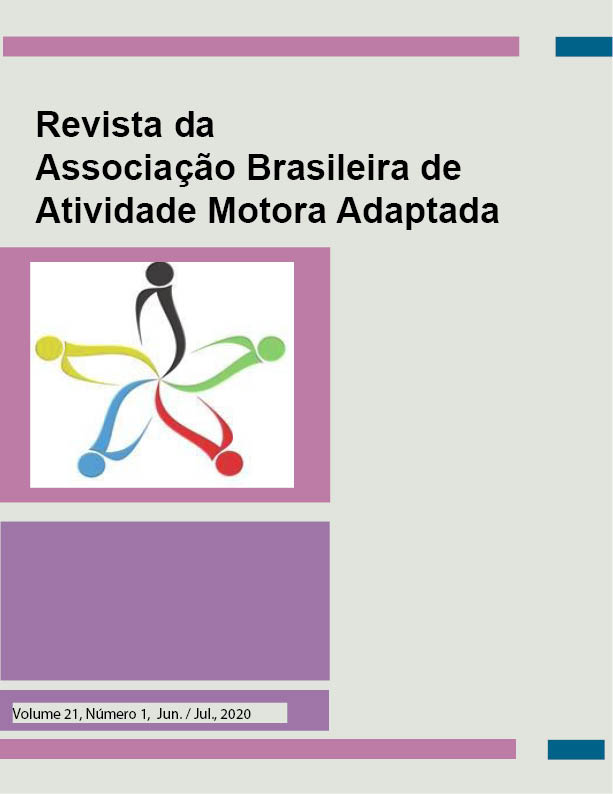INCLUSION AND THE ADAPTED SPORT IN THE PHYSICAL EDUCATION: WHAT DO THE PUBLIC-SCHOOL TEACHERS THINK ABOUT IT?
DOI:
https://doi.org/10.36311/2674-8681.2020.v21n1.04.p45Keywords:
Adapted Physical Education, Disabled child, InclusionAbstract
Children, disabilities and Adapted Sports make up the range of relevant and recurring themes in the Adapted School Physical Education, influencing the discussion about new methodological possibilities in the educational process. In this sense, we seek perspectives and new paths for Adapted Sports as a content of Adapted School Physical Education. Thus, the purpose of this study was to identify inclusion and Adapted Sports in School Physical Education from the perspective of public-school teachers in the city of Campinas, highlighting the difficulties and the possibilities in the inclusive teaching process.For this, the qualitative and quantitative methodological approach was adopted, using a guide for semi-structured interview, outlined from the Pilot Project, composed of initial anamnesis and 9 open questions, divided into three specific thematic axes: inclusion and the child with disabilities, Adapted Physical Education and institutional support and support. Eight public physical education teachers from public schools were interviewed at 2019. Participants had an average age of 44 years, completed their graduation 20 years ago and worked with 10 children with disabilities. The results showed that, despite the effective understanding of the applicability of Adapted Sports, the application effectiveness is still inefficient. The guiding aspect emphasized in this article is related to Adapted Sports as content of Adapted Physical Education. Thus, we open a new window of fundamental scientific possibilities for the development of research in adapted sports. Therefore, new paths are awakened, and because it is a process and not an end, new scientific proposals and interdisciplinary proposals are possible.
Received on: 04/17/2020
Reformulated on: 05/23/2020
Accepted: 05/24/2020
References
ALVES, M.L.T.; DUARTE, E. A exclusão nas aulas de Educação Física: Fatores associados com participação de alunos com deficiência. Revista Movimento, Porto Alegre/RS, v. 19, n. 01, p. 117-137, 2013.
ALVES, M.L.T.; STORCH, J.A.; HARNISCH, G.; STRAPASSON, A.; FURTADO, O.L.P.; LIEBERMAN, L.; ALMEIDA, J.J. G.; DUARTE, E. A aula de Educação Física e a Inclusão da criança com deficiência: Perspectiva de Professores Brasileiros. Revista Movimento, Porto Alegre/RS, v.23, n. 04, p. 1229-1244, 2017.
BARDIN, L. Análise de Conteúdo. Reimpressão - 6ª Ed. São Paulo: Edições 70, 2011.
BARRETO, M. A.; FRANCISCO, E.A.; VALE, L.H. Análise das publicações sobre inclusão de pessoas com deficiência nas aulas de Educação Física Escolar. Revista Pensar a Prática, Goiás, v. 17, p. 530-545, 2014.
BLOCK, M.E.A. Teacher’s Guide to Including Students with Disabilities: General Physical Education. 3a. ed. Baltimore: Paul H. Brookes Publishing Co., 2007.
BORGMANN, T.; ALMEIDA, J.J.G. Esporte Paralímpico na Escola: Revisão Bibliográfica. Revista Movimento, Porto Alegre/RS, v. 21, n. 1, p.53-68, 2015.
BRASIL. DCN. Lei 9.394/96 – Lei nº 9.394, 20 de dezembro de 1996. Diretrizes Curriculares Nacionais da Educação Básica. Ministério da Educação. 1996.
BRASIL. DCN. Lei 9.394/96 – Lei nº 9.394, 20 de dezembro de 1996. Atualizações de Diretrizes Curriculares Nacionais da Educação Básica. Ministério da Educação 2013.
______. Declaração de Salamanca e linha de ação sobre necessidades educativas especiais. Brasília: UNESCO, 1994.
______. LBI. Lei 13.146/15 – Lei nº 13.146/15, de 06 de julho de 2015. LBI - Lei Brasileira da Inclusão. Estatuto da Pessoa com Deficiência - Mara Gabrilli (Rel.), 2015.
______. PCN. Secretaria de Educação Fundamental. Parâmetros Curriculares Nacionais PCNs (Livro da Educação Física para Ensino Fundamental), MEC, Brasília, 1997.
______. PCN. Secretaria de Educação Fundamental. Parâmetros Curriculares Nacionais PCNs (Livro da Educação Física para Ensino Fundamental), MEC, Brasília, 2000.
CARVALHO, C.L.; ARAÚJO, P.F.; Inclusão escolar de alunos com deficiência: Interface com os conteúdos da Educação Física. Rev. Educación Física y Ciencia, Universidad Nacional de La Plata, Argentina/BA, vol. 20, n. 1, e041, 2018.
CENSO DEMOGRÁFICO 2010. Características gerais da população, religião e pessoas com deficiência. Rio de Janeiro: IBGE, 2012. Disponível em://ftp.ibge.gov.br/Censos/ Censo_Demografico_2010. Acesso em: Agosto/2019.
CONSTITUIÇÃO FEDERAL - Constituição da República Federativa do Brasil. Diário Oficial, 1988.
FERREIRA, A.F.; RAMOS, G. N. S. (Orgs.). Educação Física Escolar e Praxiologia Motriz: Compreendendo as práticas corporais. Ed. CRV, v. 22, Curitiba/PR, 2017.
GIMENEZ, R.; FREITAS, A. (Orgs.). Educação Física Inclusiva na Educação Básica: Reflexões, Propostas e Ações. Ed. CRV, Curitiba/PR, 2015.
MELLO, M.T.; WINCKLER, C.O.F. Esporte Paralímpico. São Paulo: Atheneu, 2012.
MUNSTER, M.A.; ALVES, M.L.T. Educação Física e Inclusão de Estudantes com Deficiência no Brasil: Contrapontos entre Legislação e Produção Científica. Revista da Sobama. Marília/SP, v. 19, n. 2, 171-184, 2018.
MUNSTER, M.A.; LIEBERMAN, L. GRENIER, M. Universal Design for Learning and Differentiated Instruction in Physical Education. Human Kinetics. 2019.
NAHAS, M.V.; MANTA, S.; SILVA, K.; RECH, R.; COSTA, B.; ILHA, T.; LOPES, A.S. Changes in the perception of school climate among Brazilian high school students. International School Health, v. 4, 42774-42779, 2017.
ROMERO, C.R.; CARMONA, E.K. Educação Física Inclusiva e Paradesporto: semelhanças e diferenças. Revista Thema, Porto Alegre/RS, v. 14, n. 1, p 29-42, 2017.
SILVA, O.O.N. A Formação e produção acadêmica na Educação Física Adaptada: uma discussão à luz das diretrizes da Educação Inclusiva no Estado da Bahia. Rev. Espaço Acadêmico. Bahia, v. 18, n. 214, 10-23, 2019.




